Have you ever thought about taking trains when visiting China? This 9 Days China train tour will take you to bustling Hong Kong. In Hong Kong, you will take the ancient Peak Tram to the top of the scenic Victoria Peak, overlooking the spectacular Hong Kong city view. After the Hong Kong tour, you will take the Hong Kong to Xiamen train to Xiamen, a great coastal city. In addition to enjoying the sea view in Xiamen, you will also visit the Tulou Clusters that are included in the World Heritage List. Fujian Tulou is an ancient Chinese architecture, where you will be impressed by the wisdom of the ancient Chinese. Contact us and make your China train tour happen.

Welcome to Hong Kong, the Pearl of the Orient! Your exciting China 9-day journey will start here.
Our guide will hold your name sign and wait for you at the exit of the airport. Then you will be transferred to your hotel, and the guide will help you with your check-in and your luggage. What you need to do is to have a good rest and prepare for the following exciting days.
Hong Kong, a modern city, is located in Southern China. It borders Shenzhen in the north and faces Macao across the sea. It was once ruled by England and then returned to China in 1997. So, western and oriental cultures harmoniously coexist in this city, making it highly open and inclusive. It boasts Victoria Harbour, Disneyland, Ocean Park and Victoria Peak. Come to Hong Kong, come to the wonderland.
Our journey begins with Victoria Peak. Our driver will pick you up at the hotel after breakfast and take you to Victoria Peak. It is also known as Mount Austin, and locally as the Peak. With an elevation of 552 meters, it is the highest hill on Hong Kong Island. It is a tourist attraction with multiple functions. On the foot of the hill stand various shops selling commodities from daily necessities to luxuries. You can also find Chinese restaurants as well as western restaurants serving dishes from different countries. Moreover, Victoria Peak is a good choice for sightseeing. We will arrange for you to take Peak Tram to get to the top of the hill, from where you could have an overlook of the bustling Victoria Harbor. And the Peak Tram here is also worthwhile to experience.
Opened to the public in 1888, Peak Tram is the earliest form of motorized public transportation in Hong Kong. It was firstly powered by coal, but now it is driven by electricity which is more energy-saving and efficient. It takes 15 minutes to the peak where stands Peak Tower. The building is seven stories high, with a total area of 10,400 square meters (112,000 square feet). It is designed in the shape of a bowl, presenting a unique architectural appearance.
To the south of Victoria Peak is today’s second stop: Aberdeen Fishing Village. We will drive for about 15 minutes. About 200 years ago, pirates occasionally stayed here for escaping from storms. More and more fishermen lived in the place and it became a village. As Hong Kong is highly urbanized, few fishing villages remain except Aberdeen. Our guide will book fishing boats for you and take you to experience traditional fishermen’s life. Traveling on the water, you will find some old shacks with hundreds of years. They have witnessed the city’s history.
After that, we will visit an open-air market, Stanley Market. There are Chinese handicrafts, garments, oil paintings … Commodities of various categories are sold and show you the local culture. On the second weekend of each month, Stanley Artsmart will be held at Stanley Square, and artists display their works. At that time, it will be very busy because tourists and locals come here to learn arts and have fun.
Free Time Suggestion:
Avenue of Stars imitates the Walk of Fame in Los Angeles of the United States and is built to memorize actors and actresses that make great contributions to the film industry. After a renovation, it is accessible to visitors in 2019 with more innovative designs. Here you can find sculptures of famous stars. For example, there is a bronze sculpture of Bruce Lee, striking his well-known martial pose. It is so vivid that it seems to be punching us! Wong Kar-wai, Maggie Cheung, Jackie Chen, and other stars have their fingerprints laid down. Avenue of Stars locates at Tsim Sha Tsui and faces Victoria Harbor. In other words, it spreads along the seashore. Therefore, wavy railings are adopted by the designer James Corner to make visitors better immerse themselves into the environment. Going around in the spot, you can enjoy the grand cityscape and learn about Hong Kong’s film culture.
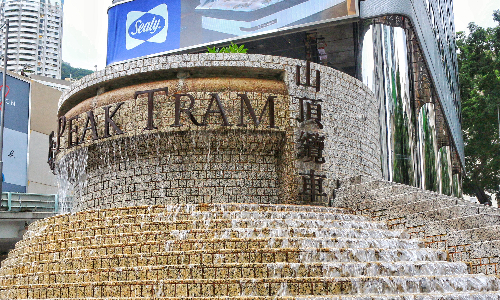
 Macau
Macau Hong Kong
Hong Kong In the morning, we will take a ferry to Macau. Upon your arrival in Macau, the local guide will pick you up at the pier and then he or she will accompany you on the following exploration of Macau. Our first destination is the Ruins of Saint Paul’s. Ruins of Saint Paul’s, with a history of more than 350 years, is the most famous symbol of Macau. It is the most representative historic site in Macau and the facade of St. Paul’s Cathedral, which was completed in 1580. It integrates the western and oriental architectural styles. It is also one of the “Eight Sights of Macau”.
The second stop is Senado Square which locates in the center of the Macau Peninsula and covers an area of 3,700 square meters. It is also locally called “the fountain” because, at its center, there is a fountain that is decorated with colorful lights and a celestial globe with Portuguese. Some surrounding buildings in western style are preserved, including the Holy House of Mercy (the oldest charity in Asia). The square is also occupied for celebrations. Every Christmas and Chinese New Year, the square will be decorated with ornaments such as Christmas trees, Chinese knots, and lanterns. Lotus is the city flower of Macau. Macau Lotus Flower Festival falls every June when 3,000 pots of the lotus of over 60 verities will be arranged at every corner of Senado Square. During that time, the whole square will be filled with the scent of lotus. Besides appreciating the graceful blossom, you are also encouraged to join activities linked to the lotus. People express their admiration for the city flower in all kinds of ways, like dance, poem, painting, photograph…
After that, we will walk about 10 minutes to Monte Fort. The construction was started in 1617 and completed in 1626. For 400 years, the internal buildings of the fort have been rebuilt many times. The fort covers an area of about 8,000 square meters. It is an irregular quadrilateral with a side length of about 100 meters. The northeast, southwest, and southeast walls of the fort are built about 9 meters high and can accommodate as many as 32 cannons. However, the northwest wall that faces the Chinese mainland is built with lower walls. This arrangement shows the fort’s defensive function towards foreign countries and friendly gesture towards China at the time.
After a lunch break, our driver will take us to Macau Tower. The altitude of the tower at the highest point measures 338 meters. It features views, restaurants, theaters, shopping malls, and entertainments. Its observation deck at level 58 provides you with amazing 360° views of Macau. And it has become a heaven for sky jump fans. The Macau Tower’s “sky jump” from the tower’s outer rim is the highest commercial sky jump in the world and also has the second-highest commercial decelerator descent facility in the world. If you are interested in this activity, your guide will help you and you can pay it onsite. Try it with the help of professional trainers, and have an unforgettable and thrilling experience.
After visiting Macau Tower, we will take a ferry back to Hong Kong. There is no schedule for the rest of the day so you can take your time as you wish.

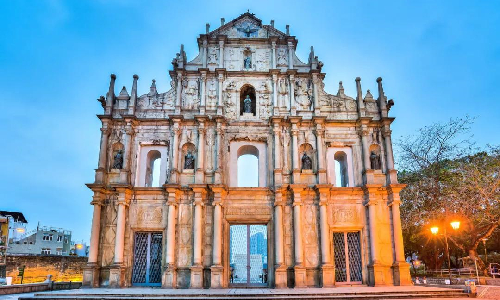
 Xiamen
Xiamen After having breakfast at the hotel, we will drive to Wong Tai Sin Temple, which is one of the most well-known temples in Hong Kong. According to local folks, Wong Tai Sin is an immortal. It is very popular because anyone who worships the immortal and prays in Wong Tai Sin Temple will be satisfied. People including residents and tourists are scrambling to burn the first incense on every first day of the Lunar New Year. In this way, they believe that they will be fortunate for the whole year. So, you can light incense and pray for yourself or your family members. A warm reminder is that every visitor can only burn 9 sticks of incense for free. In addition, it is the only temple in Hong Kong that can hold Taoist weddings. If we are lucky enough, we may witness a wedding and join the celebration. More importantly, we will have a chance to learn Taoist culture. Among the five major religions in China, Taoism is the only one that originated in China and was founded by the Chinese based on the theory of Tao Te Ching (Dao De Jing).
In the east of the Wong Tai Sin Temple is Chi Lin Nunnery, the second stop of today’s trip. Chi Lin Nunnery is a Buddhist holy land that functions to promote Buddhism, carry out charitable courses, and provide aged care services. In ancient times, the duty of nuns was only to learn scriptures and understand Buddhism. But today, as you can see, the nuns here are dedicated to helping the poor, the sick, and the elderly. The temple imitates the existing Tang Dynasty(618-907) temples in China and Buddhist temples in Mogao Grottoes’ Murals. The construction began in 1934 and it was opened to the public in 2000. Nan Lian Garden and the Hall of the Heavenly Kings are the two main areas accessible to visitors. There is a huge golden Buddha statue in the center of the Hall of the Heavenly Kings, which is guarded by the four heavenly kings. Located in front of the hall is the elegant lotus garden-Nan Lian Garden with four clear lotus pools. The lotus pools and Buddhist music will purify your soul.
After a lunch break, you will go to Xiamen by the estimated train G3002 14:33/18:23. After arriving there, our colleagues will meet you at the railway station and drive you to the hotel.
Xiamen is a beautiful coastal city and it is also a garden city in China. It is located in Fujian Province, southeast China, and faces Taiwan Province across Taiwan Strait. Xiamen is famous for its rich natural and cultural resources, specifically for its sea scenes, Buddhist temples, and ethnic minority-style villages. It has been selected as one of the best holiday destinations in China. Listed as a special economic zone, Xiamen attracts people all around the world. It is very suitable for traveling.
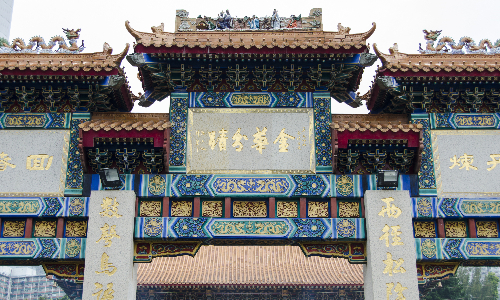
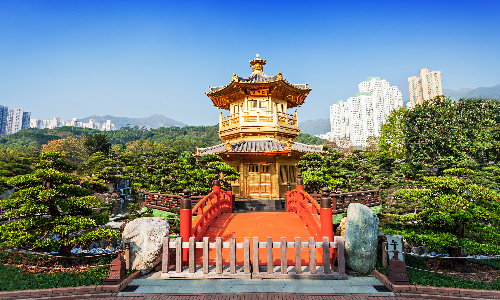
After breakfast, we will drive you to the first stop of our journey today: Island Ring Boulevard which is considered the most beautiful road in China. It is 31 KM long, 44-60 meters wide, with two-way six lanes and 80-100 meters wide green belt. It is one of the main scenic tourist roads in Xiamen by fully demonstrating subtropical scenery. The 9-kilometer long section from Xiamen University to Qianpu is called the golden coastline, integrating tourism, sightseeing, and entertainment.
Our next stop is Nanputuo Temple, a Buddhist temple. The temple has a building area of around 21,000 square meters and is adjacent to Xiamen University. It is one of the national key Buddhist temples in the Han nationality area and one of the Buddhist resorts in southern Fujian. Therefore, it is an academy for Buddhists or Buddhist scholars. The temple is time-honored for it was built during the late Tang Dynasty (618 — 907). Either buildings or collections in it are priceless relics. For example, a sutra finished in the Wanli period (1573 -1620) of the Ming Dynasty is well treasured here. With numerous Buddhist relics, the temple has played a great role in cultural exchanges in past centuries.
After lunch, we will take a boat to Gulangyu Island. It is listed as a National AAAAA level tourist attraction and one of the most beautiful islands in China for its large vegetation coverage. Tourists choose here to spend holidays because of abundant tourist resources and comfortable weather. You will first visit Sunlight Rock here. It is a boulder with a height of more than 40 meters. According to a legend, the rock’s name was changed by Zheng Chenggong (a famous ancient general) who thought it was an excellent site to enjoy sceneries. From then on, literati and poets came here and left their words on the stone. You can still read many carvings here.
After that, you will visit Shuzhuang Garden which was built in 1913. It is located in the south of Gulangyu Island. It was privately owned at first and opened to the public as a park in 1955. The whole garden is divided into two parts: Canghai Garden and Bushan Garden, and every attraction here is arranged in an orderly way. It features both the elegance of the Southern China courtyard style and the magnificence of sea sceneries. The two elements harmoniously complement each other. The last spot you will visit is Piano Museum inside the Shuzhuang Garden. It has two floors. Displayed here are precious pianos from the collections of the patriotic overseas Chinese Mr. Hu. For instance, there are four-corner pianos with the loudest sound in the world, as well as the clavichord with upside-down black and white keys made by famous piano maker Shu Nan in 1906.
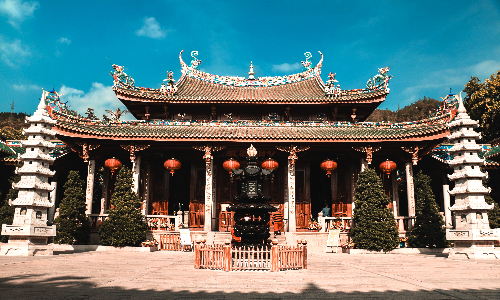
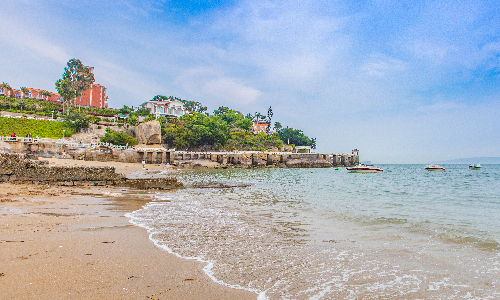
 Yongding
Yongding After breakfast, we will drive westward for about 3 hours (200 KM) to Yongding. When arriving, we will have lunch at a local restaurant before we start the journey to Chuxi Tulou Cluster. Chuxi Tulou Cluster is the residence of the Hakka people. It was constructed as early as the Ming Dynasty (1368 ―1644) and was expanded in the following centuries. At present, Chuxi Tulou Cluster consists of five round buildings and dozens of square buildings. All of their names include “qing” which means fortune and prosperity in Chinese, like Jiqing Building, Huaqing Building, Yuqing Building, and so on.
Among the buildings, Jiqing Building is the oldest one with a history of 600 years. It was built in 1419. It is a construction of wood and has more than 200 rooms divided by 72 staircases. There were 500-plus people living in here. But now, rooms on the first floor are transformed for displaying local cultures, such as carving art, opera, fortune-telling, and block printing.
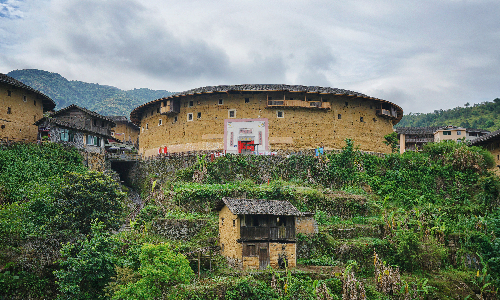
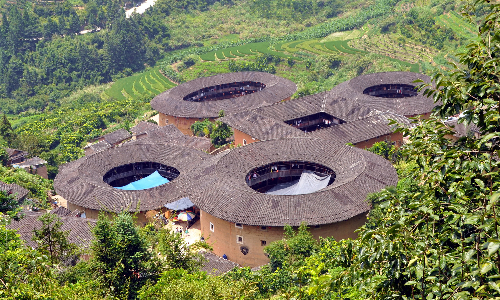
After breakfast at the hotel, we will drive southeast for about 50 minutes (30 KM) to Taxia Village. We will have a lunch break and then go on the trip to Tianluokeng Tulou Cluster.
Tianluokeng Tulou Cluster was built in 1662 with a history of more than 300 years. It includes a square building, three annular buildings, and an oval building. Each building represents one of the Five Elements (metal, wood water, fire, and earth). Chinese believe Five Elements are the components of the world and the Five Elements generate and restrict each other. In this way, the layout of the Tianluokeng Tulou Cluster presents harmony and unity between human beings and nature. It is thus praised as a treasure in architecture in the world. On July 7, 2008, Tianluokeng Tulou Cluster together with other Tulou was listed in the world cultural heritage list by UNESCO.
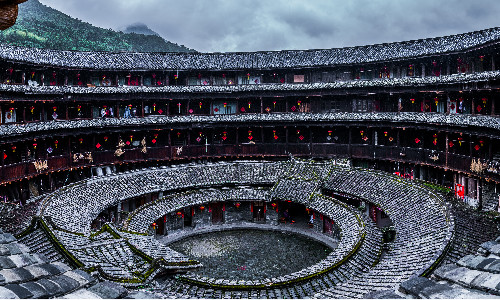
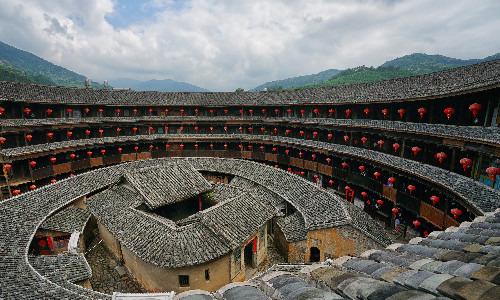
 Xiamen
Xiamen After visiting the Tianluokeng Tulou Cluster, we will drive back to Xiamen. You can arrange the schedule as you wish for the rest of the day, or stay in the hotel for a good rest and pack your luggage.
 Hong Kong Departure
Hong Kong Departure After having breakfast, you will take an estimated train G3001 10:06/13:53 back to Hong Kong. Our colleagues will be waiting for you at the exit. And then you will be transferred to the airport and fly back to your sweet home. The guide will help you to check in your luggage. Look forward to seeing you again.
| City | Five Star hotel list | Four Star hotel list |
|---|---|---|
| Hong Kong | Harbour Grand Kowloon | Harbour Plaza North Point Hotel |
| Xiamen | Jingmin Hotel Central Xiamen | Xiamen Huaqiao Hotel |
| Yongding | Hakka Tulou Prince Hotel Longyan | Hakka Tulou Prince Hotel Longyan |
 |
![]() About your child or infant, please contact us for a discounted price.
About your child or infant, please contact us for a discounted price.



We started with a few days in Beijing & ended in Shanghai, from where we visited the Forbidden City and Great Wall. In between we visited Terra Cotta Warriors Museum, Panda Base, Shanghai Disneyland.

We had a wonderful holiday in China which will remain long in the memory. China is a breathtakingly beautiful country full of splendid temples and palaces, mountains and rivers, peaceful rural scenes and bustling shopping streets.
 QUICK ENQUIRY
QUICK ENQUIRY